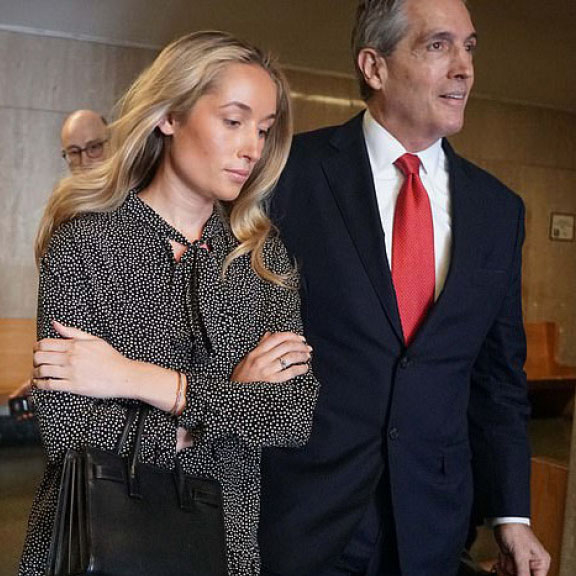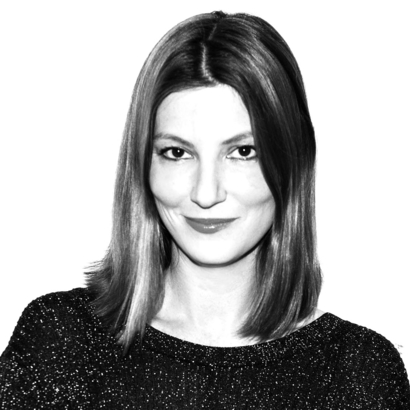Somewhere in New York City, an exceptionally beautiful 26-year-old woman is serving three years’ probation on top of 15 days of community service, having pleaded guilty to making $32,209 in unauthorized charges on her boss’s credit card. She is apparently looking for a new job.
Her name is Yvonne Bannigan. The boss in question is Grace Coddington, Vogue’s esteemed creative director–at–large, and because of that people care. Especially readers of the New York Post, which gave Bannigan the paparazzi treatment as she left the Manhattan Criminal Court after her July 2018 hearing.
In the image that was splashed over Page Six after her sentencing 10 months later, Bannigan resembles the sort of best friend/sister/girlfriend/assistant that you’d mostly like but also kind of hate. She wears a wistful expression that’s undeniably sad, but not fatally so. There’s makeup, but it’s tasteful—foundation, bronzer, swipes of mascara, and lip gloss. Her freshly brushed hair is the shade of honey blonde that’s usually the $450 handiwork of Michelle Williams’s colorist. Swanning down the hallway of New York Supreme Court in a long-sleeved black dress, printed with tiny white polka dots—probably not something as plebeian as Theory, but maybe Ganni?—she could just as easily be walking into a casting call for the reboot of Gossip Girl.
An All-American Beauty from Dublin
Bannigan radiates the brand of healthy, all-American beauty that Vogue has relentlessly celebrated, both on its covers and in its high-profile hires. Had things turned out differently, one could imagine her, or someone who looks like her, on the dance floor at the Plaza hotel for the Save Venice Gala, shimmying around in a borrowed ball gown, lifting up her glittery cat’s-eye mask to wave to Lauren Santo Domingo. (Who was, you’ll remember, a junior editor at Vogue before she married into a family of billionaires and became her generation’s closest approximation of Babe Paley.) Occasionally, and maybe even often, people who stick it out in New York end up becoming the people they came to New York to be.
“I remember walking across Sixty-second Street one twilight that first spring, or the second spring, they were all alike for a while. I was late to meet someone but I stopped at Lexington Avenue and bought a peach and stood on the corner eating it and knew that I had come out of the West and reached the mirage. I could taste the peach and feel the soft air blowing from a subway grating on my legs and I could smell lilac and garbage and expensive perfume and I knew that it would cost something sooner or later—because I did not belong there, did not come from there.”
—Joan Didion, Slouching Towards Bethlehem

Bannigan was born and raised in Dublin, Ireland, one of three children born to Francine Shelly, a onetime makeup artist, and Brendan Bannigan, who ran a library-supply business. In the spring of 2013, Bannigan arrived in New York and scored an internship in the public-relations department at Zac Posen. She took courses at Parsons and worked as a greeter in Abercrombie & Fitch’s Fifth Avenue flagship, chatting up tourists. Soon, she landed at Elle as an intern. Things were happening. According to her LinkedIn profile, Bannigan spent six months trafficking samples, assisting on shoots, and filing expense reports. (This is two years after a former Hearst intern named Diana Wang filed a federal lawsuit against the publisher on behalf of more than 3,000 other interns, claiming unfair labor practice.)
And then, there was Vogue. It was happening. In February 2015, Bannigan landed at the magazine—or, rather, “brand,” as it now refers to itself—as an assistant in the fashion-and-accessories department under Coddington. And when Vogue’s in-house creative director left full-time employment for an at-large role for the magazine, Bannigan soon followed. By February 2016, she was working for Grace Coddington L.L.C.
Unauthorized Charges
Just two months later, the thievery allegedly began, and it continued for two years until Coddington filed a complaint in early 2018. According to the editor, who was listed as “Informant 1” in court papers, Bannigan’s unauthorized charges totaled $53,564. Shortly after the investigation began, Bannigan’s silver-tongued lawyer, Michael Cornacchia, told the Irish Independent that his client was “puzzled” by the charges, given that she had “nursed” Coddington through two surgeries and a stroke. He continued, “Never, ever during these two years did Coddington, who checked her credit card statements and kept track of her possessions, complain to Yvonne or anyone else about Yvonne’s conduct or any misuse of credit cards or misappropriation of any of her property. In fact, Yvonne was the one who suggested that Coddington go to the police to report the questioned charges and Coddington went to the police the next day with Yvonne’s encouragement.”
And yet, one month later, Bannigan was in court on felony charges of second- and third-degree larceny. She was also accused of taking more than $9,000 in commission payments from selling Coddington’s shoes, bags, and accessories on the Real Real, the luxury consignment site. “This case is driven by Grace Coddington, and as such, her credibility, recollection and motives in bringing this case will be scrutinized by us and hopefully the district attorney,” warned Cornacchia to the court. (Through her lawyer, Bannigan declined to speak to Air Mail, and e-mails to Coddington’s office and agency were not returned.)
Except that Coddington is among the most stand-up characters in the fashion industry, with an untarnished reputation and gilded credentials. The 78-year-old has been with Vogue since she was a teenage model in her native Britain, and became a bona-fide celebrity upon the 2009 release of the documentary The September Issue. Coddington has hosted a talk show, designed a capsule collection for Louis Vuitton, and even sold a memoir for a reported $1.2 million. “Fashion isn’t just frocks,” she once told The Economist. “It’s how we do our houses, our gardens, it’s what we eat and drink.” Coddington and her longtime partner, the hairstylist Didier Malige, shuttle between New York City and Wainscott, where the walls of their ranch are lined with photographs by friends and collaborators like Helmut Newton, Bruce Weber, Patrick Demarchelier, and Irving Penn.
The Dream Version of Yourself
Inez & Vinoodh, the heralded fashion-photography team, even turned their lens on Coddington in 2016. She was flanked by many of her former and current assistants, including Anne Christensen, the stylist and former fashion director of T: The New York Times Style Magazine; Jessica Diehl, the former fashion-and-style director of Vanity Fair (and a contributing editor at Air Mail); and, indeed, Yvonne Bannigan. Coddington is “an extraordinary mentor,” raves the writer Lauren Mechling in the accompanying story in Teen Vogue. “To hear her former assistants tell it, Grace is less a boss than older sister, life compass, and brilliant collaborator rolled in one.... Those who work alongside Grace learn not only about how she concocts images that are like silent, two-dimensional operas, but how to draw inspiration from sources where nobody else thought to look.”
And yet Coddington is a key figure in an industry where all art has a commercial purpose. Even her most spellbinding images for Vogue delicately suggest that the reader at least consider treating herself to a little something from Viktor & Rolf or Marc Jacobs or Giambattista Valli. And while the influence of print magazines is in precipitous decline, the siren call to decamp to New York and become the dream version of yourself remains as irresistible as ever. For the past 20 years, movies and television shows have waged a relentless P.R. campaign for the industry and its lifestyle: in chronological order, Just Shoot Me!, Sex and the City, Project Runway, The Devil Wears Prada, The Hills, The City, The Bold Type, So Cosmo … and so they come, these young women like Yvonne Bannigan, in search of a better-looking life.

But disillusionment arrives fast and furiously. According to an informal poll of high-profile stylists, it’s unlikely that Bannigan’s salary topped $50,000 a year. Withholding for taxes and a 401(k) contribution, the bi-weekly take-home pay comes to around $1,400. Public records indicate that Bannigan shared a two-bedroom, one-bathroom apartment in a complex in the far East Village, and she probably paid about $2,250 a month for the privilege. Even in the far East Village, a cappuccino still costs five dollars, and that’s before the upcharge for non-dairy milk. An unlimited Metrocard for New York’s dysfunctional subway system remains $127 a month.
So they come, these young women, in search of a better-looking life.
When Yvonne Bannigan had the opportunity to steal, she evidently stole. It could have been pre-meditated and pathological, or dumb and impulsive. Maybe she worked late one night and ordered sushi on Seamless. Took an Uber home, instead of the subway. Maybe she was instructed to buy four different sizes of gold hoop earrings, and she threw in a fifth for herself. The charges average out to about $1,342 a month, which is fairly easy to achieve when one considers the cost of luxury fashion. It is now entirely possible to spend $555 on a bikini (Eres) or $145 on a bottle of perfume (Grace by Grace Coddington). Or maybe Bannigan was just Amazon-ing her toilet paper.
“I like my money right where I can see it: hanging in my closet.”
—Carrie Bradshaw, Sex and the City
We don’t really know, because it seems that few members of New York’s fashion elite really knew her. She has kept her Instagram account primarily private, although earlier this week it was public, at least for a moment. It had not been scrubbed of any mention of her former life—instead, it seems to serve at least in part as a memorial. Moments from her fashion career abound: Coddington in front of a window at Harrods, in London; Bannigan and friends in Halloween makeup at a V Magazine party; a signed copy of Grace: 30 Years at Vogue: “‘For Yvonne, with love, Grace Coddington’ … what?!”
On February 20, the day after Karl Lagerfeld died, and a few months before her sentencing, Bannigan posted a moody black-and-white selfie, sitting on a sofa at Chanel’s headquarters on the Rue Cambon in Paris during what was presumably a trip there with Coddington, who styled several 2018 campaigns for the brand. “A little fashion pup at the Chanel Atelier in Paris, ahead of our campaign shoot with Patrick Demarchelier - pure magic. #karl,” it was captioned. She just couldn’t help herself.
“The girl could not have been sweeter in real life,” said one seasoned fashion editor, who encountered Bannigan through dealings with her boss. “Mind you, the underlying condition of entitlement, in her case full-blown and severe, is pervasive and completely entrenched amongst her peers.”
Entitlement can be systemic when you’re breathing the most rarefied air in the universe. You don’t go to places like Vogue to make money; you go to make yourself. Yvonne Bannigan was not the only person to work at a glossy magazine and get a little too caught up in the world that it covers, often a little too chummily. She was not the first to fudge her expenses. But she’s a criminal now, even though she only looks like she could play one on TV. According to her Instagram, though, all might not be lost. On June 9, she posted a video of a Manhattan sunset taken from a far-flung land across the East River. Williamsburg, maybe. She captioned the image with a quote from Dorothy Parker: “New York is always hopeful.” But for now, according to an obscure Internet job board, she’s looking for a position in hospitality. Yvonne Bannigan, at your service.
Ashley Baker is the Style Editor for AIR MAIL


